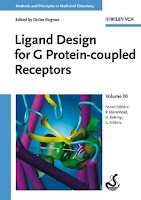Describe in one book all existing approaches for designing ligands targeting G protein-coupled receptor (GPCR), is an impossible challenge. However, giving some clues to help drug designers in their daily work is feasible. This is precisely the aim of the current book whose contributors have been selected to reflect current knowledge about an extraordinary family diversity of the objectives of the protein.
G protein-coupled receptor (GPCR) represent the best of our knowledge at least 60% of all recipients. The vast majority kept alive as the most interesting of the objectives in the search for drugs and development. About 18,000 Reviews are listed in PubMed, many of them dealing with the structural characteristics and peculiarities of the G protein-coupled receptors. Especially their functional classification, association with other integral membrane proteins and the dimerization / oligomerization behavior remains a hot topic in research.
However, the existing body of knowledge in atomic resolution allows us to propose a mechanism of interaction and patterns of activation of this receptor type.
 This book is a volume of 12 chapters on the state of the art in the design of ligands for these targets. The volume begins with a description of the genome in GPCR, which is followed by a proper analysis of available data and its appearance and use of databases. In the more specialized chapters raises the question of how to de-orphanize receptors. Strategies in these areas are urgently needed because of HTS strategies, technologies of the matrix, etc. The number of orphan receptors has increased exponentially.
This book is a volume of 12 chapters on the state of the art in the design of ligands for these targets. The volume begins with a description of the genome in GPCR, which is followed by a proper analysis of available data and its appearance and use of databases. In the more specialized chapters raises the question of how to de-orphanize receptors. Strategies in these areas are urgently needed because of HTS strategies, technologies of the matrix, etc. The number of orphan receptors has increased exponentially.
The ligand interaction does not mean that a product will come out of this knowledge. Thus druggability analysis, which has exceeded its infant years of rule-based estimates, it has become a sophisticated methodology alone. One chapter is devoted to human GPCR druggability. Is the molecular mechanism that lights up in depth within the next three chapters. Oligomerization or simply dimerzation, activation and inactivation processes of allosteric regulation are complex puzzles to solve, last but not least, due to difficulties in understanding the contribution of entropy.
Subsequent chapters are devoted to the calculation procedures. Chemical genomics approaches will be presented, the detection of specific library development and privileged structures for interaction and GPCR laedhopping and virtual screening approaches for ligand design.
The last three chapters deal with the 3D-structures of GPCRs and usefulness as a basis for rational design of ligands. Both methods of modeling and virtual screening were discussed in depth.
G protein-coupled receptor (GPCR) represent the best of our knowledge at least 60% of all recipients. The vast majority kept alive as the most interesting of the objectives in the search for drugs and development. About 18,000 Reviews are listed in PubMed, many of them dealing with the structural characteristics and peculiarities of the G protein-coupled receptors. Especially their functional classification, association with other integral membrane proteins and the dimerization / oligomerization behavior remains a hot topic in research.
However, the existing body of knowledge in atomic resolution allows us to propose a mechanism of interaction and patterns of activation of this receptor type.
 This book is a volume of 12 chapters on the state of the art in the design of ligands for these targets. The volume begins with a description of the genome in GPCR, which is followed by a proper analysis of available data and its appearance and use of databases. In the more specialized chapters raises the question of how to de-orphanize receptors. Strategies in these areas are urgently needed because of HTS strategies, technologies of the matrix, etc. The number of orphan receptors has increased exponentially.
This book is a volume of 12 chapters on the state of the art in the design of ligands for these targets. The volume begins with a description of the genome in GPCR, which is followed by a proper analysis of available data and its appearance and use of databases. In the more specialized chapters raises the question of how to de-orphanize receptors. Strategies in these areas are urgently needed because of HTS strategies, technologies of the matrix, etc. The number of orphan receptors has increased exponentially.The ligand interaction does not mean that a product will come out of this knowledge. Thus druggability analysis, which has exceeded its infant years of rule-based estimates, it has become a sophisticated methodology alone. One chapter is devoted to human GPCR druggability. Is the molecular mechanism that lights up in depth within the next three chapters. Oligomerization or simply dimerzation, activation and inactivation processes of allosteric regulation are complex puzzles to solve, last but not least, due to difficulties in understanding the contribution of entropy.
Subsequent chapters are devoted to the calculation procedures. Chemical genomics approaches will be presented, the detection of specific library development and privileged structures for interaction and GPCR laedhopping and virtual screening approaches for ligand design.
The last three chapters deal with the 3D-structures of GPCRs and usefulness as a basis for rational design of ligands. Both methods of modeling and virtual screening were discussed in depth.


